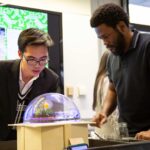
High school students primed for success in STEM
Posted: December 13, 2010

Blake Francis (right), a senior at Red Mountain High School, came out of his shell and learned to communicate with all types of students as a result of his participation in the Prime the Pipeline project.
After nearly three years, a successful grant-funded after-school program for high school students across Arizona is receiving recognition from the state and funds to expand the program to younger students.
In fall 2007, ASU’s Carole Greenes and colleagues received a $1.35 million grant from the National Science Foundation (NSF) to fund a three-year project to increase the number of students who enroll in and complete college majors in preparation for careers in the STEM sectors: science, technology, engineering and math.
“The intent of the ‘Prime the Pipeline Project (P3): Putting Knowledge to Work’ is to increase high school students’ interest and achievement in STEM fields, as well as to update mathematics and science high school teachers’ knowledge of those subjects,” said Greenes, professor and associate vice provost of STEM education.
Students and teachers meet at ASU’s Polytechnic campus after school for nine weeks each semester and two weeks in the summer, and work in scientific villages on challenging STEM projects. With leadership from professors and scientists, villages have focused on projects in engineering design, alternative energy, biotechnology, aviation, trauma simulation, computer gaming, design of computer applications for Apple devices, photography, music composition and modification, documentary movie production, and 3D modeling of structures for emergency services.
Data collected since the start of the project show that Pipeline students have significantly higher GPAs and have taken a greater number of advanced STEM-related courses in high school than their peers in the control group. The control group is composed of students who expressed interest or started in the project, but had to excuse themselves from it for varying reasons.
Another stunning finding is that at the start of the Pipeline Project, only 23 percent of students in both the project and control groups said they planned to attend college after high school. After more than a year, 100 percent of Pipeline students said they plan to attend college as compared to 43 percent of the control group. And when asked about an intended college major, 58 percent of Pipeline students identified a STEM field.
“Students participating in the Pipeline Project see that they are able to compete with peers from other high schools, are able to get around a college campus without getting lost, and are able to communicate and understand professors. College is less intimidating. Most importantly, they realize that they are college capable,” Greenes said.
And for Blake Francis, a senior at Red Mountain High School in Mesa, the Pipeline Project brought him out of his shell.
“I’m a shy person, but participating in the program helped me grow and learn to communicate with all types of people,” he said. “Now, I’m looking forward to going to college to become a dentist or orthodontist.”
“Pipeline teachers are learning that students bring a great deal of knowledge and experience to the problem-solving exercises, that they are capable of a lot more than we expect, and that they want to be challenged,” said Mary Cavanaugh, director of the Pipeline Project and executive director of the PRIME Center. “It’s important to let the students explore. “
Pipeline teachers have learned new ways of teaching, including to step back and give students time to think and wrestle with new ideas and hard problems.
“The wind turbine village brought to light that really all we need to do is give enough direction to students and let them loose to discover, learn and be curious,” said Lisa Knipp, who has taught for 21 years and is currently a mathematics teacher and department chair at Highland High School in Gilbert. “From this experience, I developed a new course that is project-based and still meets the math curriculum requirement for the district.”
The program is making headway in other ways, too. In October, “Prime the Pipeline Project: Putting Knowledge to Work” was one of three after-school programs to receive the Arizona Center for After School Excellence Award.
And, in November, an expansion of the Pipeline Project to middle school students and their teachers, was funded by the Helios Education Foundation. “STEM in the Middle” (SIM) will focus on grades 5-8 students and their teachers. Several Pipeline Project students will serve as mentors to students in those scientific villages. Several Pipeline Project teachers also will participate as scientific village leaders in SIM.
“Starting the pipeline to college earlier in students’ educational careers will help to build a stronger STEM work force for Arizona,” Greenes said.
Media Contact:
Christine Lambrakis, [email protected]
(480) 727-1173
(602) 316-5616


































